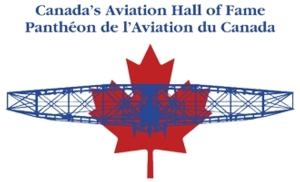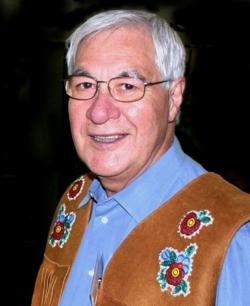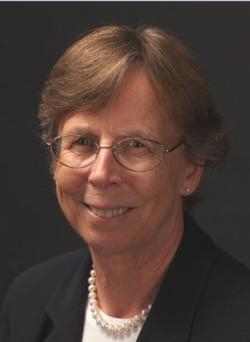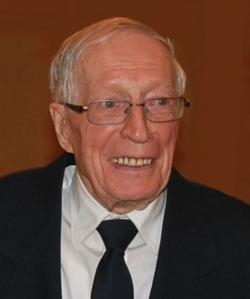Also Names 'Belt Of Orion' Recipient For 2016
Canada’s Aviation Hall of Fame (CAHF) will induct four new members, and recognize a Belt of Orion recipient, at its 43rd annual gala dinner and ceremony, to be held Thursday June 9, 2016, at the Canada Aviation and Space Museum, at Rockcliffe Airport in Ottawa.

The new members are Frederick James Carmichael: northern Canada aviation entrepreneur; Kathleen Carol Fox: Flight Instructor and Transportation Safety Board of Canada Chairwoman; William Ross Lennox, RCAF pilot and Chief Test Pilot P&WC; and Beverley Strahan Shenstone: aerodynamicist and aeronautical engineer
The Royal Canadian Naval Air Branch (1945-1968) will receive the Belt of Orion Award for Excellence
CAHF inductees are selected for their contributions to Canada’s development through their integral roles in the nation’s aviation history. This year’s inductees will join the ranks of the 220 esteemed men and women inducted since the Hall’s formation in 1973.
Tom Appleton, CAHF chairman of the board of directors, said, “The CAHF is proud to honor these four well-deserving individuals for their significant contributions to Canadian aviation, and to Canada’s development as a nation. “Our 2016 inductees come from backgrounds that span the width of Canada’s unique aviation industry. Aviation has brought Canadians together as a country, unlike any other form of transport. Our new inductees reflect that cohesion through their pioneering activities and spirit.”

Frederick James Carmichael, C.M.: Fred Carmichael has spent over 60 years in Northern aviation in the course of which his accomplishments as an aviation entrepreneur, search and rescue pilot, mentor for aspiring aboriginal youth, pioneer aboriginal commercial pilot and contributor to community life in the North-West Territories have made him a legend. In 1955, he was the first aboriginal person in the North to get a pilot's license. He has worked as a commercial pilot and started up two of his own aviation companies, Reindeer Air Service and Antler Aviation. He has been recognized widely for his accomplishments both locally and throughout the country. He was made a Member of the Order of Canada in 2010.

Kathleen Carol Fox: Kathy Fox has dedicated her entire life to the aviation community in Canada both through her personal activities in the flight instruction, sport aviation and sport parachuting fields but also in her professional capacities in the promotion and advancement of flight safety. In this latter role, she has had an outstanding career in the air traffic control community, transitioning on to Nav Canada where she reached the highest levels of management and then, following retirement with the Transportation Safety Board of which she was appointed Chair in 2014. During all of this time she has continued to play an active role in the general aviation world promoting flight safety and assisting with the training and examination of aspiring aviators at all levels.

William Ross Lennox: Ross Lennox was involved in aviation in Canada for over six decades, retiring as chief test pilot and head of flight operations for Pratt & Whitney Canada with over 23,000 hours flown during which he was responsible for several remarkable accomplishments. From his beginnings in the wartime RCAF culminating in duties as a Dakota pilot in Europe, he moved on to nearly twenty years in the Canadian north during which time he operated helicopters in support of the DEW Line project. In 1963 he joined United Aircraft of Canada and shortly thereafter flew the first-ever unescorted helicopter transit of the North Atlantic. Other significant accomplishments included test flying every one of the RCN’s order of Sikorsky Sea Kings and all subsequent development work on this aircraft, completing the testing of the PT6 engine, and serving as lead test pilot for the PW100, JT15D and PT-6-50 engines. He was recognized officially by many organizations for his
thousands of hours of incident free flying, his promotion of safety and his outstanding work as a search and rescue pilot. Mr. Lennox died in November 2013.

Beverley Strahan Shenstone: Only belatedly recognized as the aerodynamicist responsible for the design of the iconic elliptical wing of the Supermarine Spitfire, Bev Shenstone is regarded as one of the greatest Canadian aeronautical engineers. He broke new ground as the first Canadian to be awarded a graduate degree in aeronautics from a Canadian university. His graduate studies on stability of the Vedette flying boat were of great use to the RCAF. He was part of the team which created the specification which led to the Canadair North Star as well as conducting applied research into airborne radar systems at the National Research Council. He was technical director for BOAC, involved in feasibility work concerning bringing SST aircraft into commercial service.
Privately, he was instrumental in the growth of institutions focussed on non-powered, and especially man-powered flight both in Canada and the UK. He was instrumental in the creation of the Soaring Council of Canada, the introduction of rules for licensing pilots, registering sailplanes and training standards plus the development of a family of gliders in conjunction with Waclaw Czerwinski. He was similarly involved with British soaring organizations and in the establishment of a series of prizes for accomplishments in man powered flight. During this period he was the only Canadian to become the president of the Royal Aeronautical Society. Mr. Shenstone died in 1979.

The Royal Canadian Naval Air Branch grew out of the wartime experience of Canadian air and naval forces as integral parts of the Royal Navy married to a decision that the Royal Canadian Navy (RCN) would develop an autonomous aviation capability. The need for this became clear with the onset of the Cold War and the need for Canadian embarked aviation resources to counter Soviet conventional and then nuclear submarine threats in the Atlantic.
From modest beginnings, the small RCN Air Branch developed a highly respected level of operational capability, both from the three carriers it employed during its lifetime but also for its ability to innovate to overcome resource constraints in the face of operational necessities. Such innovation was evidenced by the pioneer work to operate anti-submarine helicopters from small surface warships, including the ground-breaking adoption of a haul-down system to permit landing on small decks. This occurred far in advance of the adoption of such systems by the RCN’s larger NATO allies.
The RCN’s Air Branch was a distinct organization that made an outstanding contribution to the advancement of aviation in Canada.
Canada’s Aviation Hall of Fame is located in the hangar at the Reynolds-Alberta Museum in Wetaskiwin, Alberta, south of Edmonton. The Hall was founded in 1973, and its inductees have come from all across Canada having led extraordinary lives as military and civilian pilots, doctors, scientists, inventors, engineers, astronauts and administrators.
The Hall strives to increase the public’s understanding and interest in aviation history by making its displays, archives, records and artefacts accessible to current and future generations. The heroism and courage embodied in the Members of the Hall serves to kindle the spirit of adventure in Canada’s youth.
The 2016 induction ceremonies and gala dinner will be held on Thursday June 9, 2016, at the Canada Aviation and Space Museum, at Rockcliffe Airport, 11 Aviation Parkway, Ottawa, Ontario, K1K 4R3.
(Images provided with Canada’s Aviation Hall of Fame news release)
 ANN's Daily Aero-Term (04.24.24): Runway Lead-in Light System
ANN's Daily Aero-Term (04.24.24): Runway Lead-in Light System ANN's Daily Aero-Linx (04.24.24)
ANN's Daily Aero-Linx (04.24.24) Aero-FAQ: Dave Juwel's Aviation Marketing Stories -- ITBOA BNITBOB
Aero-FAQ: Dave Juwel's Aviation Marketing Stories -- ITBOA BNITBOB Classic Aero-TV: Best Seat in The House -- 'Inside' The AeroShell Aerobatic Team
Classic Aero-TV: Best Seat in The House -- 'Inside' The AeroShell Aerobatic Team Airborne Affordable Flyers 04.18.24: CarbonCub UL, Fisher, Affordable Flyer Expo
Airborne Affordable Flyers 04.18.24: CarbonCub UL, Fisher, Affordable Flyer Expo








